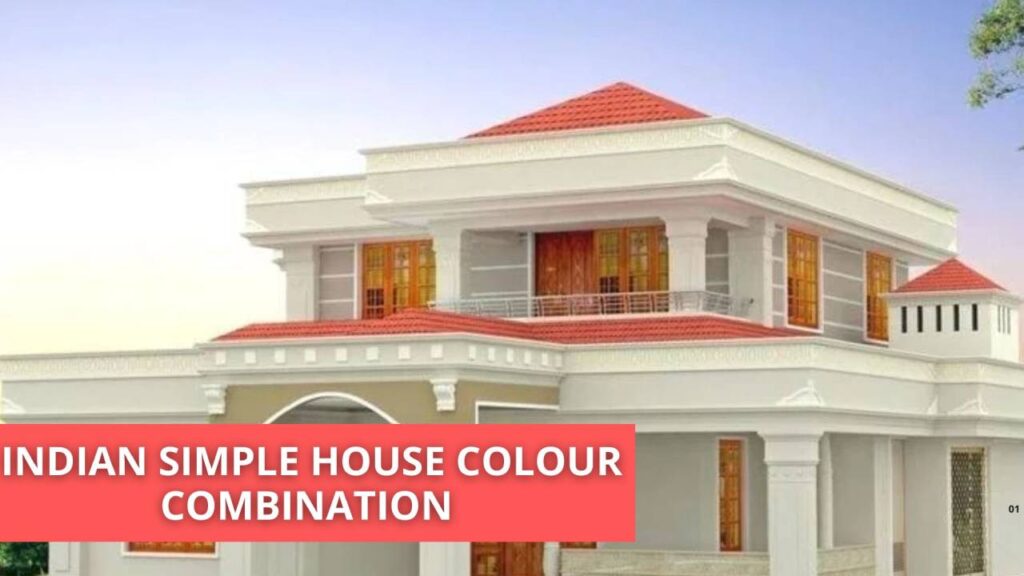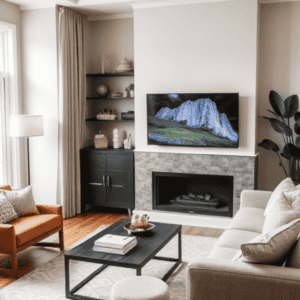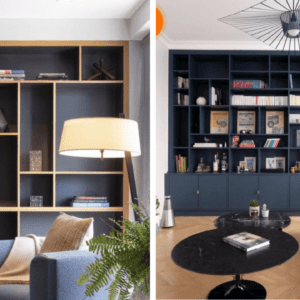
The exterior color of a building is important as it helps to shape the building through its look and style. In India, since there are traditional and contemporary styles, getting the perfect color combination for the outside area of a house is important. A carefully planned and designed exterior color scheme adds to the pandas of the house but also brings out the elegance and culture in the persons residing in that house. In this article, we paint simple and beautiful designs that are ideal for Indian houses without abandoning tradition and modernity.
The Importance of Choosing the Right Exterior House Colour Combination

Choosing the best color scheme for Indian residential houses involves simple and advanced research. It incorporates beliefs, architectural features of the region, and even the climate of the region. Perception is affected in various ways and these colors do influence a person as well as the home and its environments. For interior and exterior color selection in India, the pallet can range from bold and bright colors most centered on attraction to warm and soft colors that tend to be more stable.
Key Considerations:
- Climate: Usually in hot and humid climates people prefer lighter colors since these walls will reflect a lot of sunlight and help keep the house cool. But in cold regions, darker colors are chosen since these will retain heat and make the house warm.
- Architectural Style: The architectural style of a house- a single style or a combination of different types- assists in color selection.
- Cultural Influences: Even Indian intercom systems have been embedded with color codes. A great resource has therefore been captured and has not been exploited. Because in India colors have a lot of significance due to the culture of the country. For example, saffron is linked to wealth, white is related to peace, and green is growth.
Timeless and Traditional Indian Exterior House Colour Combinations

1. White and Brown: The Classic Duo
White being considered a clean and unadulterated color finds its use in the outer wall of most Indian homes. Its beauty is complemented by the use of brown tones of wood doors, window frames, trims, and others bringing out warmth and class. Not only does the white paint on the house make the place bright and inviting but also the brown components give a warm tone to the house. This works very well for both classical and modern Indian homes.
2. Yellow and Red: Vibrant and Festive
Yellow and red are colors that are often associated with Indian people. Yellow stands for cheerfulness, abundance, and warmth while red stands for vitality and power. These colors may often be seen on traditional Indian houses, especially in the classic Indian architectural regions. There is a stirring and celebratory feel due to the contrast of the bright yellow outer wall and the red roofing tiles or other accentuation. This combination of colors especially suits the Indian style of architecture like havelis and bungalows.
3. Beige and Maroon: Understated Elegance
If you are looking for something simple but still looks elegant, you can with confidence choose beige and maroon which work perfectly well together. Beige, being dull and not special in its features works as an excellent base color for the exterior while maroon works to make it interesting and richer. This is typical of the traditional houses with a little modification made in the North Indian states of Rajasthan and Gujarat. The shades of brown and milk add an idyllic style as they inspire calmness in hosting areas.
4. Cream and Green: Nature-Inspired Harmony
The hues of cream and green have calming properties and have a connection to nature. Those who live in areas surrounded by greenery or wish to bring into a home such a soft tone would find such a combination very suitable. The creamy color of the exteriors helps in giving balance as the cleanness of plants on building headlines, shutters, or greenery organize, enhances the outlook. Such a combination is good for both modern as well as classical Indian homes, especially those having a garden.
Modern and Minimalist Indian Exterior House Colour Combinations

1. Grey and White: Sleek and Contemporary
Modern Indian dwellings are bedecked primarily in grey or white tones. These neutral tones are applied to exude a simple and sleek approach while at the same time making the house unique in its subtle sophistication. When light grey or charcoal grey is the dominant color with bright white trims, the whole look is tidy and sophisticated. These colors are most appropriate for modern-styled urban households.
2. Blue and White: Coastal-Inspired Serenity
People who want an exterior that provides a nice sense of quietness and relaxation will appreciate blue and white exteriors. Taking cues from the coast, this combination is particularly suited for residences located near water or in a temperate area. White is indeed the very much loved background color but a pale blue embellished with white accents is very eye-catchy in all senses of the word. The blend is equally good for traditional and modern Indian homes and will provide a calming effect to the exterior of the houses.
3. Terracotta and Ivory: Earthy and Warm
Terracotta has been the color of innumerable Indian homes for ages. It epitomizes the heat and richness of Indian earth and culture. Used with ivory or off-white color, terracotta lends an elegant and inviting façade. Moreover, warm shades of terracotta are attractive, providing an inviting warmth while neutral ivory supplies light and contrast. This combination is perfect for homes with a rustic or ethnic vibe, especially in regions where traditional architecture is prevalent.
4. Olive Green and Sandstone: Subtle and Chic
For an understated yet stylish façade, olive green pairs well with sandstone. The earthily toned olive green blends well with nature while the sandstone offers a quiet accent. This combination is perfect for houses targeting a cleaner and more modern aesthetic but still wish to embrace nature. It especially works well for construction activities in hilly or forested areas as the exterior shade complements aptly with the site.
Regional Influences on Indian Exterior House Colour Combinations

The colors of the house facades are influenced by the ethnicity and geography of the country and the history of the cultural practices of the people. Let’s analyze the effect of such geographical segments on the actual choice of color combinations:
1. North India: Earthy and Warm Tones
In the North region, mainly Rajasthan and Punjab, earthy and warm colors are used in the majority of the house exteriors. The primary colors used are ochre, maroon, terracotta, and beige. The choice of these colors is rooted in the culture and history of the sub-region. The houses in these areas are generally well adorned with details and finishes which are brought to life by vibrant color choices.
2. South India: Coastal Hues and Pastels
In the southern states, where coastal influence is prominent, pastel shades and coastal hues are widely used. Light blue, turquoise, mint green, and white are common exterior colors, reflecting the region’s connection to the sea and the relaxed lifestyle. In cities like Chennai and Kochi, homes often feature a mix of traditional architecture with modern pastel color schemes, creating a harmonious blend of old and new.
3. West India: Vibrant and Festive Colors
In West India, especially in Maharashtra and Gujarat, vibrant colors like saffron, pink, and bright yellow are popular. These bold colors are a reflection of the region’s lively festivals and cultural exuberance. Traditional homes in this region often feature intricate woodwork and colorful exterior walls, creating a visually striking appearance.
4. East India: Rich and Royal Tones
The eastern part of India being culturally very rich has influenced the types of houses to be built in that region. Bright shades of red, maroon, and gold are particularly used in this area for housing plants as it signify the richness and opulence of civilization. In states such as West Bengal and Odisha, it is customary to have ancestral houses
5. Tips for Choosing the Perfect Exterior House Colour Combination

Keep in mind the following when thinking about color combinations for the outside of your house in India:
- Begin with a Base Color: Select a neutral base color that colors outside the pre-dominantly. It will understate all else.
- Use Secondary Color: All trims, doors, and windows will use a different color from the base color. Such accent colors must be made in moderation and not overdone.
- Take Note of the Environment: The bordering vegetation, buildings, and even culture should be taken into consideration. No such colour scheme should stand out more than the rest.
- Check First Hand: Do variations of the colors recommenced on that section such as coloring a small section on the wall where these colors will be implemented and observe it during daylight, evening, or even daylight.
- Don’t Go Stray From The Style: Be it conservative design, contemporary combination, or somewhere in the middle, considering the architectural style of fulfilling the whole purpose of shade combinations showing warmth at home.
Conclusion
The outside color of an Indian house relates not only to home decor but also to culture and the personality of its owner. There are some great timeless traditional combinations, but modern ones have much to offer too. If you love capturing taste in active mood bursting colors, or dim blanched skin tones, your house can still be liveable and enhancive with the proper colors. A color scheme can be applied to match the home decoration trends yet bring out the beauty that adds to the addictiveness.










